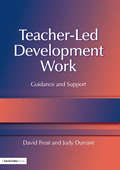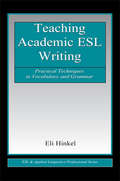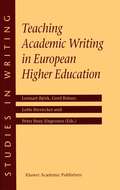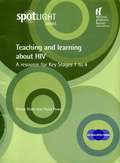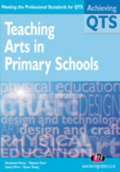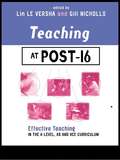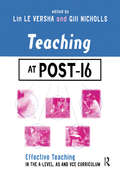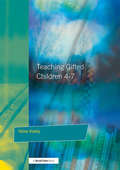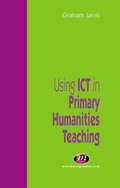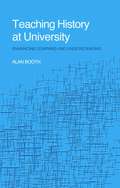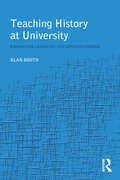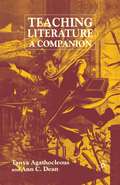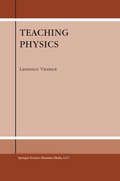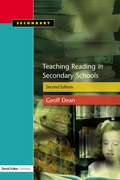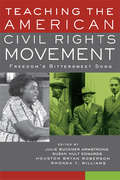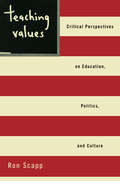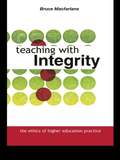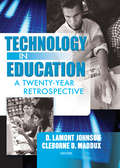- Table View
- List View
Teacher-Led Development Work: Guidance and Support
by David Frost Judy DurrantThis is a practical step-by-step guide to how the quality of teaching and learning in schools can be improved through the development of organizational capacity and professional networking. Whether you're involved in the National College of School Leadership's Networked Learning Communities scheme, or simply wish to enable teachers to initiate and sustain education change, this replacement to David Frost's earlier Reflective Action Planning for Teachers will be of great benefit. The book demonstrates how secondary and primary teachers can contribute fully to the improvement of their school, while pursuing their own continued professional development and gaining accreditation through school-based work. It provides guidelines for school managers, higher education tutors, external consultants and LEA advisors establishing school-based support, and gives tried and tested flexible proformas, checklists and other practical tools that are ideal for training, INSET or a personal audit.
Teaching Academic ESL Writing: Practical Techniques in Vocabulary and Grammar (ESL & Applied Linguistics Professional Series)
by Eli HinkelTeaching Academic ESL Writing: Practical Techniques in Vocabulary and Grammar fills an important gap in teacher professional preparation by focusing on the grammatical and lexical features that are essential for all ESL writing teachers and student-writers to know. The fundamental assumption is that before students of English for academic purposes can begin to successfully produce academic writing, they must have the foundations of language in place--the language tools (grammar and vocabulary) they need to build a text. This text offers a compendium of techniques for teaching writing, grammar, and lexis to second-language learners that will help teachers effectively target specific problem areas of students' writing. Based on the findings of current research, including a large-scale study of close to 1,500 non-native speakers' essays, this book works with several sets of simple rules that collectively can make a noticeable and important difference in the quality of ESL students' writing. The teaching strategies and techniques are based on a highly practical principle for efficiently and successfully maximizing learners' language gains. Part I provides the background for the text and a sample of course curriculum guidelines to meet the learning needs of second-language teachers of writing and second-language writers. Parts II and III include the key elements of classroom teaching: what to teach and why, possible ways to teach the material in the classroom, common errors found in student prose and ways to teach students to avoid them, teaching activities and suggestions, and questions for discussion in a teacher-training course. Appendices to chapters provide supplementary word and phrase lists, collocations, sentence chunks, and diagrams that teachers can use as needed. The book is designed as a text for courses that prepare teachers to work with post-secondary EAP students and as a professional resource for teachers of students in EAP courses.
Teaching Academic ESL Writing: Practical Techniques in Vocabulary and Grammar (ESL & Applied Linguistics Professional Series)
by Eli HinkelTeaching Academic ESL Writing: Practical Techniques in Vocabulary and Grammar fills an important gap in teacher professional preparation by focusing on the grammatical and lexical features that are essential for all ESL writing teachers and student-writers to know. The fundamental assumption is that before students of English for academic purposes can begin to successfully produce academic writing, they must have the foundations of language in place--the language tools (grammar and vocabulary) they need to build a text. This text offers a compendium of techniques for teaching writing, grammar, and lexis to second-language learners that will help teachers effectively target specific problem areas of students' writing. Based on the findings of current research, including a large-scale study of close to 1,500 non-native speakers' essays, this book works with several sets of simple rules that collectively can make a noticeable and important difference in the quality of ESL students' writing. The teaching strategies and techniques are based on a highly practical principle for efficiently and successfully maximizing learners' language gains. Part I provides the background for the text and a sample of course curriculum guidelines to meet the learning needs of second-language teachers of writing and second-language writers. Parts II and III include the key elements of classroom teaching: what to teach and why, possible ways to teach the material in the classroom, common errors found in student prose and ways to teach students to avoid them, teaching activities and suggestions, and questions for discussion in a teacher-training course. Appendices to chapters provide supplementary word and phrase lists, collocations, sentence chunks, and diagrams that teachers can use as needed. The book is designed as a text for courses that prepare teachers to work with post-secondary EAP students and as a professional resource for teachers of students in EAP courses.
Teaching Academic Writing in European Higher Education (Studies in Writing #12)
by Lennart Björk Gerd Bräuer Lotte Rienecker Peter Stray JörgensenThis volume describes in detail teaching philosophies, curricular structures, research approaches and organizational models used in European countries. It offers concrete teaching strategies and examples: from individual tutorials to large classes, from face-to-face to web-based teaching, and addresses educational and cultural differences between writing instruction in Europe and the US.
Teaching and Learning About HIV: A Resource for Key Stages 1 to 4 (PDF)
by Paula Power Simon BlakeTeaching and Learning about HIV highlights the role that schools can play in providing education and support about HIV. It provides teachers and others working in schools with a rationale for teaching about HIV, including: legislation and guidance; guidance on ensuring effective policy development; background information about HIV and AIDS; and activities for use with children and young people, from Key Stage 1 to 4. The activities in Teaching and Learning about HIV have been tried and tested, and include those for young people with special educational need. The resource also includes ideas for addressing HIV in different areas of the curriculum, such as Circle Time and Citizenship.
Teaching Arts In Primary Schools (PDF)
by Stephanie Penny Raywen Ford Lawry Price Susan YoungThis concise introduction to teaching arts subjects in primary schools supports trainee and newly-qualified teachers in their teaching of four core arts subjects: art and design, design and technology, music and physical education. Written around the Professional Standards for QTS, each chapter includes practical guidance on topics such as the National Curriculum, QCA schemes of work, planning, assessment, differentiation and teaching using ICT. Throughout the book, practical tasks highlight important concepts and research summaries provide a concise guide to theoretical principles.
Teaching at Post-16: Effective Teaching in the A-Level, AS and GNVQ Curriculum
by Lin Le Versha Gill NichollsThe post-16 sector is the focus of great change in education and this book provides all teaching professionals with a guide to exploring and developing successful teaching in this new environment.With contributions from education experts and subject specialists, this book addresses the issues that now face teachers at post-16. It guides readers through the new requirements in a simple and accessible way; looks at teaching and learning issues in detail and considers the professional development of those teaching at this level. Essential reading for all post-16 teachers in schools and colleges.
Teaching at Post-16: Effective Teaching in the A-Level, AS and GNVQ Curriculum
by Lin Le Versha Gill NichollsThe post-16 sector is the focus of great change in education and this book provides all teaching professionals with a guide to exploring and developing successful teaching in this new environment.With contributions from education experts and subject specialists, this book addresses the issues that now face teachers at post-16. It guides readers through the new requirements in a simple and accessible way; looks at teaching and learning issues in detail and considers the professional development of those teaching at this level. Essential reading for all post-16 teachers in schools and colleges.
Teaching Gifted Children 4-7: A Guide for Teachers
by Valsa KoshyThis book offers practical guidelines on how to identify gifted and talented young children and looks at ways to enhance their learning opportunities. Provided are a wealth of practical, tried and tested strategies that readers will be able to use in their classrooms with confidence. It includes advice on how to create the right classroom environment, guidance on how to assess and record children's talents, a list of suggested appropriate resources, and help with planning the curriculum. The emphasis is on creating a classroom environment that encourages children to be engaged in higher order thinking skills, exploration and creativity; the importance of play and the role of questioning is highlighted. Using case studies of young gifted children and rooted in theoretically sound principles, this book makes a significant contribution to the learning and teaching of younger children. Teachers, teaching assistants, advisers, Gifted and Talented Coordinators and training teachers will find this book relevant to their needs.
Teaching Gifted Children 4-7: A Guide for Teachers
by Valsa KoshyThis book offers practical guidelines on how to identify gifted and talented young children and looks at ways to enhance their learning opportunities. Provided are a wealth of practical, tried and tested strategies that readers will be able to use in their classrooms with confidence. It includes advice on how to create the right classroom environment, guidance on how to assess and record children's talents, a list of suggested appropriate resources, and help with planning the curriculum. The emphasis is on creating a classroom environment that encourages children to be engaged in higher order thinking skills, exploration and creativity; the importance of play and the role of questioning is highlighted. Using case studies of young gifted children and rooted in theoretically sound principles, this book makes a significant contribution to the learning and teaching of younger children. Teachers, teaching assistants, advisers, Gifted and Talented Coordinators and training teachers will find this book relevant to their needs.
Teaching Handbooks Series: Using ICT in Primary Humanities Teaching (PDF)
by Graham JarvisThis is a brief and easy to use handbook for trainee primary teachers and newly qualified teachers who want to use ICT to enhance the teaching and learning of History, Geography, RE and Citizenship. It focuses on the National Curriculum requirements for ICT, and uses the QCA Schemes of Work as a structure for activities. Useful web resources are included and suggestions are made for different approaches to ICT depending on the level of resources available.
Teaching History at University: Enhancing Learning and Understanding
by Alan BoothAlan Booth draws on a wide range of international research as well as the reflections and experiences of university historians, linking theory and practice. Teaching History at University examines how high-quality history teaching and learning can be achieved in today's universities worldwide. This is an essential resource for university teachers and all those who are responsible for ensuring the quality of teaching and learning policies and practices within their institutions.
Teaching History at University: Enhancing Learning and Understanding
by Alan BoothAlan Booth draws on a wide range of international research as well as the reflections and experiences of university historians, linking theory and practice. Teaching History at University examines how high-quality history teaching and learning can be achieved in today's universities worldwide. This is an essential resource for university teachers and all those who are responsible for ensuring the quality of teaching and learning policies and practices within their institutions.
Teaching Literature: A Companion
by T. Agathocleous A. DeanIn Teaching Literature scholars explain how they think about their everyday experience in the classroom, using the tools of their ongoing scholarly projects and engaging with current debates in literary studies. Until recently, teaching has played second fiddle to literary research as a mode of knowledge in academia, leaving new teachers with nowhere to turn for advice about teaching and no forum for discussion of the difficulties and opportunities they face in the classroom.
Teaching Physics
by L. ViennotThis book seeks to narrow the current gap between educational research and classroom practice in the teaching of physics. It makes a detailed analysis of research findings derived from experiments involving pupils, students and teachers in the field. Clear guidelines are laid down for the development and evaluation of sequences, drawing attention to "critical details" of the practice of teaching that may spell success or failure for the project. It is intended for researchers in science teaching, teacher trainers and teachers of physics.
Teaching Reading in the Secondary Schools
by Geoff DeanThis book outlines several approaches to reading which challenge former classroom practices. It is through these approaches that all students - from reluctant boys to the most able of either gender - can continue to grow as readers and develop their readiness to seek meaning in texts.
Teaching Reading in the Secondary Schools
by Geoff DeanThis book outlines several approaches to reading which challenge former classroom practices. It is through these approaches that all students - from reluctant boys to the most able of either gender - can continue to grow as readers and develop their readiness to seek meaning in texts.
Teaching the American Civil Rights Movement: Freedom's Bittersweet Song
by Julie Buckner Armstrong Susan Hult Edwards Houston Bryan Roberson Rhonda Y. WilliamsThe past fifteen years have seen renewed interest in the civil rights movement. Television documentaries, films and books have brought the struggles into our homes and classrooms once again. New evidence in older criminal cases demands that the judicial system reconsider the accuracy of investigations and legal decisions. Racial profiling, affirmative action, voting districting, and school voucher programs keep civil rights on the front burner in the political arena. In light of this, there are very few resources for teaching the civil rights at the university level. This timely and invaluable book fills this gap. This book offers perspectives on presenting the movement in different classroom contexts; strategies to make the movement come alive for students; and issues highlighting topics that students will find appealing. Including sample syllabi and detailed descriptions from courses that prove effective, this work will be useful for all instructors, both college and upper level high school, for courses in history, education, race, sociology, literature and political science.
Teaching the American Civil Rights Movement: Freedom's Bittersweet Song
by Julie Buckner Armstrong Susan Hult Edwards Houston Bryan Roberson Rhonda Y. WilliamsThe past fifteen years have seen renewed interest in the civil rights movement. Television documentaries, films and books have brought the struggles into our homes and classrooms once again. New evidence in older criminal cases demands that the judicial system reconsider the accuracy of investigations and legal decisions. Racial profiling, affirmative action, voting districting, and school voucher programs keep civil rights on the front burner in the political arena. In light of this, there are very few resources for teaching the civil rights at the university level. This timely and invaluable book fills this gap. This book offers perspectives on presenting the movement in different classroom contexts; strategies to make the movement come alive for students; and issues highlighting topics that students will find appealing. Including sample syllabi and detailed descriptions from courses that prove effective, this work will be useful for all instructors, both college and upper level high school, for courses in history, education, race, sociology, literature and political science.
Teaching Values: Critical Perspectives on Education, Politics, and Culture
by Ron ScappIn Teaching Values, Ron Scapp wrests the discussion of values and values-based education away from traditionalists who have long dominated educational debates. While challenging the Right's domination of the discussion of values education, Scapp examines some issues not typically raised by educators and critics on the Left, including the positive role of citizenship and national identity in U.S. education and culture.
Teaching Values: Critical Perspectives on Education, Politics, and Culture
by Ron ScappIn Teaching Values, Ron Scapp wrests the discussion of values and values-based education away from traditionalists who have long dominated educational debates. While challenging the Right's domination of the discussion of values education, Scapp examines some issues not typically raised by educators and critics on the Left, including the positive role of citizenship and national identity in U.S. education and culture.
Teaching with Integrity: The Ethics of Higher Education Practice
by Bruce MacfarlaneThis is a book about the ethics of teaching in the context of higher education. While many books focus on the broader socially ethical topics of widening participation and promoting equal opportunities, this unique book concentrates specifically on the lecturer's professional responsibilities. It covers the real-life, messy, everyday moral dilemmas that confront university teachers when dealing with students and colleagues - whether arising from facilitated discussion in the classroom, deciding whether it is fair to extend a deadline, investigating suspected plagiarism or dealing with complaints. Bruce Macfarlane analyses the pros and cons of prescriptive professional codes of practice employed by many universities and proposes the active development of professional virtues over bureaucratic recommendations. The material is presented in a scholarly, yet accessible style, and case examples are used throughout to encourage a practical, reflective approach.Teaching With Integrity seeks to bridge the pedagogic gap currently separating the debate about teaching and learning in higher education from the broader social and ethical environment in which it takes place.
Teaching with Integrity: The Ethics of Higher Education Practice
by Bruce MacfarlaneThis is a book about the ethics of teaching in the context of higher education. While many books focus on the broader socially ethical topics of widening participation and promoting equal opportunities, this unique book concentrates specifically on the lecturer's professional responsibilities. It covers the real-life, messy, everyday moral dilemmas that confront university teachers when dealing with students and colleagues - whether arising from facilitated discussion in the classroom, deciding whether it is fair to extend a deadline, investigating suspected plagiarism or dealing with complaints. Bruce Macfarlane analyses the pros and cons of prescriptive professional codes of practice employed by many universities and proposes the active development of professional virtues over bureaucratic recommendations. The material is presented in a scholarly, yet accessible style, and case examples are used throughout to encourage a practical, reflective approach.Teaching With Integrity seeks to bridge the pedagogic gap currently separating the debate about teaching and learning in higher education from the broader social and ethical environment in which it takes place.
Technology in Education: A Twenty-Year Retrospective
by Cleborne D Maddux D Lamont JohnsonExamine the history of the microcomputer and its impact on education! Under the editorship of D. LaMont Johnson, PhD, a nationally recognized leader in the field of educational computing, Computers in the Schools has been a powerful tool in educational settings. Now, after 20 years, Professor Johnson muses on how far information technology has come. Technology in Education: A Twenty-Year Perspective brings you a retrospective look at the trends and issues relating to the integration of computers into the school curriculum covering 25 years. He joins several other colleagues to follow the historical journey of the "dream machine" to the technological wonder it has become. Technology in Education: A Twenty-Year Perspective will leave you better informed on such topics as: the obstacles slowing the integration of information technology in education-why are computers still collecting dust in many classrooms? the predictions that were made by early computer enthusiasts, and how close or off the mark those predictions came how information technology has impacted education and society so far historical advances in education that should be celebrated, such as the advent of the World Wide Web the student&’s perspective of computers in education and much more! Computers in the Schools is the one of the oldest academic journals dealing directly with the integration of information technology into the educational setting. Technology in Education: A Twenty-Year Perspective provides an important overview by some of the leading experts in the field. From the earliest predictions and opinions to the latest trends and findings, this book, celebrating the journal&’s twentieth anniversary, is a vital research tool for students and professors of information technology in education.
Technology in Education: A Twenty-Year Retrospective
by Cleborne D Maddux D Lamont JohnsonExamine the history of the microcomputer and its impact on education! Under the editorship of D. LaMont Johnson, PhD, a nationally recognized leader in the field of educational computing, Computers in the Schools has been a powerful tool in educational settings. Now, after 20 years, Professor Johnson muses on how far information technology has come. Technology in Education: A Twenty-Year Perspective brings you a retrospective look at the trends and issues relating to the integration of computers into the school curriculum covering 25 years. He joins several other colleagues to follow the historical journey of the "dream machine" to the technological wonder it has become. Technology in Education: A Twenty-Year Perspective will leave you better informed on such topics as: the obstacles slowing the integration of information technology in education-why are computers still collecting dust in many classrooms? the predictions that were made by early computer enthusiasts, and how close or off the mark those predictions came how information technology has impacted education and society so far historical advances in education that should be celebrated, such as the advent of the World Wide Web the student&’s perspective of computers in education and much more! Computers in the Schools is the one of the oldest academic journals dealing directly with the integration of information technology into the educational setting. Technology in Education: A Twenty-Year Perspective provides an important overview by some of the leading experts in the field. From the earliest predictions and opinions to the latest trends and findings, this book, celebrating the journal&’s twentieth anniversary, is a vital research tool for students and professors of information technology in education.
